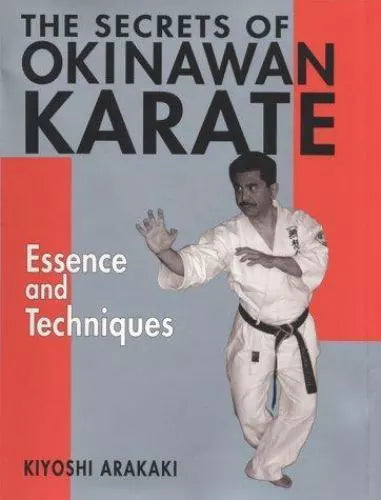The Secrets of Okinawan Karate: Essence & Techniques Book by Kiyoshi Arakaki (Hardcover) (Preowned)
ESTE ES UN PEDIDO ESPECIAL
Estos artículos pueden tardar aproximadamente entre 1 y 2 semanas en llegar aquí antes de que estén listos para ser enviados por el servicio de mensajería seleccionado. Los artículos de pedidos especiales no son elegibles para devolución o cambio bajo ninguna circunstancia. Revise atentamente los detalles del producto antes de agregar estos artículos a su carrito de compras.
Tenga en cuenta: si realiza un pedido de otros artículos, se retendrán y enviarán junto con el artículo del pedido especial cuando esté disponible. Alternativamente, puede realizar pedidos por separado para que sus artículos habituales se envíen antes.
There are two karate styles in Okinawa, and these two have different methods of tsuki, or punches. One style is called Shuri-te and the other Naha-te. This book deals mainly with Shuri-te style, and from time to time compares it with Naha-te style.
In both styles, instead of simply moving a solid object (the fist) from point A to point B, you consciously increase the speed of the fist as you punch. On television and in movies you have seen a cowboy crack a whip, making a sound that helps him move cattle into an enclosure. Some cowboys even use these skills in rodeo competition. It is so natural for them that they can produce the crack without thinking. This crack that exceeds the speed of sound is a key to karate. The tsuki of Shuri-te is like this whip (diag. 2). Think of your entire body -- waist, arm, wrist, and fingers -- as a whip delivering a tsuki that exceeds the speed of sound. This is the key to how a small and skinny person can fight successfully against a big, muscular opponent.
In Shuri-te, the energy point is the center of the body. This body center, the waist, is like the wrist of a cowboy cracking his whip. From this point you produce energy and transfer the energy to your opponent. Using the waist rotation method, you treat your body like a hard object. However, if you think of the body as a rigid object, you lose fluidity and cannot transfer all your body's energy to your target. If you use waist rotation as the key to producing power, the result will be more like using a length of 2 x 4 rather than a whip. The weight and mass of the 2 x 4 would be powerful but would lack the speed and explosion of energy delivered by the whip. Try whipping your waist, thinking of the waist as the center of your body. Opposing muscles will snap it first forward, then instantaneously back (figs. 3-4). This should feel the same as a cowboy's wrist moving up and down as he creates a whipping motion and energy. At this point, bulky body parts like tightened muscles and stabilized joints would interfere in the transfer of this whiplike energy.
This whipping motion applies not only to the waist but also to the arm, which is part of the same body-whip. It is completely different from the tsuki of modern karate, where a tight fist travels from the waist to a target in as straight a line as possible. Tsuki should be delivered this way: a fist is cocked at one's side near the waist. The fist, arm, and elbow stay close to the body until the fist reaches the center of the body. The fist begins moving out toward the target while arm and elbow are still touching the body, extending straight to the target. Turn the fist from inside to outside as the elbow leaves the body, hitting the target at the split second of completing the fist rotation. You must turn your arm from inside to outside like a whip in order to transfer the energy created from your body (figs. 5-7). Think of a willow tree with a supple trunk, a branch, and a leaf (diag. 3). The trunk is the grip part of the whip, the branch is the main body of the whip, and the leaf is the tip of the whip. After a fist departs from the body, it must snap like a whip while turning from inside to outside.
This usage of wrist and fingers has only been passed down by oral tradition. Thus, this core concept has been lost even in Okinawa.
The energy transfer of tsuki in Okinawan karate accelerates like a rocket that has a three-level booster system to increase its speed as it departs from earth. The best way for you to transfer your energy is to become like gelatin. If your body is as hard as a rock, you just absorb energy into your body. But when you touch gelatin, it vibrates. The gelatin transfers the energy it has just received. This thought can be applied to a whip, too. A whip is flexible. Therefore, you must not tighten up any part of your body, especially the arm and hand. You never make a tight fist to hit a target. Even after hitting the target, you loosen up your hand. Only a few Okinawan karate practitioners still know about this. Actually, you never consciously tighten the fist. Just as a good whipping motion moves fluidly from the wrist to the tip of a whip, so must your tsuki move with one unbroken motion from waist to target (figs. 8-9). Instead, you simply allow the target to curl the fingers into a fist (figs. 10-11). The only time the fist tightens is during the fraction of an instant when the fist reaches the center of the target. This is the only way to dig the fist into the target, because you can transfer 100 percent of your energy to the target without any loss (figs. 12-14). The experts, of course, hit the target with their knuckles at a 90-degree angle, and they are able to change the wrist angle instinctively to optimize contact with the target.
The tsuki of Shuri-te will always quiver because the whipping motion of the body creates energy and transfers energy completely. If a whip does not quiver, it is not a whip, it is a stick. If your body is like a stick, you destroy the speed of the tsuki. If you shake and whip the arm, the arm will relax naturally after striking and transferring energy to the target. There should be no moment when you see a punch stop in the tsuki of Shuri-te. Contrast this with modern karate, which uses the action-reaction method of pulling back the left hand to the waist so as to send energy into the right hand punch, much like a set of mechanical pistons.
When those karate practitioners who understood and performed the essence of karate as a martial art began to migrate from Okinawa to Japan and introduce karate, there were not enough of them to teach properly. They tried to teach karate to Japanese who did not have an understanding of karate by using pictures which only showed frozen moments of karate movement. This was no more successful than teaching a sports novice how to play football by using a few photos and limited instruction. As a result, the Japanese misinterpreted the Inner Physical Dynamic System of karate as being based on mechanical engineering. Thus, the essence of the original was lost.
160 pages
No se pudo cargar la disponibilidad de recogida


